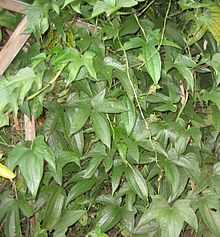Dioscorea trifida
| Dioscorea trifida | |
|---|---|
 | |
| Scientific classification | |
| Kingdom: | Plantae |
| (unranked): | Angiosperms |
| (unranked): | Monocots |
| Order: | Dioscoreales |
| Family: | Dioscoreaceae |
| Genus: | Dioscorea |
| Species: | D. trifida |
| Binomial name | |
| Dioscorea trifida L.f. | |
Dioscorea trifida is a species of flowering plant in the family Dioscoreaceae. It is a species of yam (genus Dioscorea). It is native to the Caribbean and Central and South America.[1] Its many common names include Indian yam,[2] cush-cush, and yampee.[1] It is called mapuey in Venezuela,[3] inhame in Brazil, tabena and ñame in Colombia, and sacha papa in Peru.[1] It is also called Nampi in Costa Rica. (tilde over the n)
This plant is a vine that can exceed 3 meters in length.[4] One plant produces up to 12 stems, which are lined with several membranous wings.[5] They emerge from roots with tubers of various shape and size, generally up to 20 centimeters long by 8 wide.[4] The leaves are up to 23[6] to 30[4] centimeters long with blades divided into pointed lobes and borne on long, winged petioles. Green flowers with six tiny tepals are borne in the axils. The fruit is a winged, lightly hairy capsule up to about 2.7 centimeters long.[6]
This is a cultivated yam species used for food in parts of the Americas, especially South America and some Caribbean nations. The starchy tuber has a thin, smooth skin marked with some cracks. It takes different shapes but is commonly spherical or club-shaped, or shaped like a horse hoof, sometimes with a cleft.[5] It comes in various colors, including white, purple, and black.[7] The crop is cultivated like the potato, but must be given a strong trellis for support. It is propagated by planting small tubers or tuber chunks. The crop can be harvested in 10 to 11 months.[5]
The tuber is cooked for food. It can be baked or boiled.[5] In Venezuela and Colombia it is mashed or used in soups.[3] In parts of the Caribbean it is known as "the best of the yams".[5] It is a staple food for some indigenous peoples.[7]
The tuber is about 38% starch.[5] It is a waxy starch that lacks amylose and has potential uses as a binder and thickener in food processing.[7]
References
- ↑ 1.0 1.1 1.2 Dioscorea trifida. Germplasm Resources Information Network (GRIN).
- ↑ Dioscorea trifida. ITIS.
- ↑ 3.0 3.1 Pérez, E., et al. (2011). Evaluation of the functional properties of promising Dioscorea trifida L. waxy starches for food innovation. International Journal of Carbohydrate Chemistry vol. 2011, Article ID 165638, 7 pages.
- ↑ 4.0 4.1 4.2 Dioscorea trifida. FAO Ecocrop.
- ↑ 5.0 5.1 5.2 5.3 5.4 5.5 Stephens, J. M. Cushcush — Dioscorea trifida L. HS590. Florida Cooperative Extension Service, University of Florida IFAS. Published 1994, revised 2009.
- ↑ 6.0 6.1 Dioscorea trifida. Smithsonian Tropical Research Institute, Barro Colorado Island.
- ↑ 7.0 7.1 7.2 Pérez, E., et al. (2010). Physicochemical, functional, and macromolecular properties of waxy yam starches discovered from "mapuey" (Dioscorea trifida) genotypes in the Venezuelan Amazon. Journal of Agricultural and Food Chemistry 59(1), 263-73.